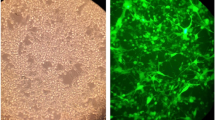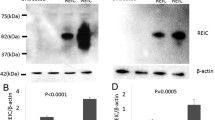Abstract
Previously, we evaluated the therapeutic efficacy of the adenovirus-mediated transduction of the cytosine deaminase (CD) gene and 5-fluorocytosine (5-FC) for malignant gliomas. However, the molecular pathways that mediate the 5-FC/CD gene therapy-induced cell death remains to be elucidated. In this study, we examined the induction of apoptosis and the role of caspases in 5-FC/CD gene therapy using human malignant glioma cells [Gli36Δ5 (mutated p53) and U87MG (wild p53)]. The treatment with 5-FC/CD gene-therapy-induced apoptosis both in Gli36Δ5 cells and in U87MG cells according to flow cytometric analysis. Immunoblot analysis revealed that caspases 3 and 9 were processed in response to 5-FC/CD in a concentration- and time-dependent manner, but caspase 8 was not. Each caspase 3 and 9 inhibitor significantly reduced apoptosis triggered by 5-FC/CD, but the caspase 8 inhibitor did not affect apoptosis induction. 5-FC/CD significantly promoted the release of cytochorme c from mitochondria in a concentration-dependent manner. These results indicate that 5-FC/CD gene therapy induces apoptosis in human malignant glioma cells and that the apoptotic cell death is mediated by the activation of mitochondrial caspase cascades involving caspases 3 and 9. This is the first report concerning the apoptotic mechanism of 5-FC/CD gene therapy, and these findings could be used to increase the efficacy of suicide gene therapy systems for the treatment of malignant glioma.
Similar content being viewed by others
References
Brock CS, Bower M: Current perspectives in gliomas. Med Oncol 14: 103-120, 1997
Moolten FL: Drug sensitivity genes for selective cancer chemotherapy. Cancer Gene Ther 1: 279-287, 1994
Culver KW, Ram Z, Wallbridge S, Ishii H, Oldfield EH, Blaese RM: In vivo gene transfer with retroviral vector-producer cells for treatment of experimental brain tumors. Science 256: 1550-1552, 1992
Wei MX, Tamiya T, Chase M, Boviatsis EJ, Chang TKH, Kowall NW, Hochberg FH, Waxman DJ, Breakfield XO, Chiocca E: Experimental tumor therapy in mice using the cyclophosphamide-activating cytochrome P450 2B1 gene. Hum Gene Ther 5: 969-978, 1994
Tamiya T, Ono Y, Wei MX, Morz PJ, Moolten FL, Chiocca EA: Escherichia coli gpt gene sensitizes rat glioma cells to killing by 6-thioxanthine or 6-thioguanine. Cancer Gene Ther 3: 155-162, 1996
Klatzmann D, Valery CA, Bensimon G, Marro B, Boyer O, Mokhtari K, Diquet B, Salzmann JL, Philippon JA: Phase I/II study of herpes simplex virus type 1 thymidine kinase ‘suicide’ gene therapy for recurrent glioblastoma. Study Group on Gene Therapy for Glioblastoma. Hum Gene Ther 9: 2595-2604, 1998
Shand N, Weber F, Mariani L, Bernstein M, Gianella-Borradori A, Long Z, Sorensen AG, Barbier N: A phase 1–2 clinical trial of gene therapy for recurrent glioblastoma multiforme by tumor transduction with the herpes simplex thymidine kinase gene followed by ganciclovir. GLI328 European-Canadian Study Group. Hum Gene Ther 10: 2325-2335, 1999
Rainov NG: A phase III clinical evaluation of herpes simplex virus type 1 thymidine kinase and ganciclovir gene therapy as an adjuvant to surgical resection and radiation in adults with previously untreated glioblastoma multiforme. Hum Gene Ther 20: 2389-2401, 2000
Mullen CA, Kilstrup M, Blaese RM: Transfer of the bacterial gene for cytosine deaminase to mammalian cells confers lethal sensitivity to 5-fluorocytosine: a negative selection system. Proc Natl Acad Sci USA 89: 33-37, 1992
Ichikawa T, Tamiya T, Adachi Y, Ono Y, Matumoto K, Furuta T, Yoshida Y, Hamada H, Ohmoto T: In vivo efficacy and toxicity of 5-fluorocytosine/cytosine deaminase gene therapy for malignant gliomas mediated by adenovirus. Cancer Gene Ther 7: 74-82, 2000
Adachi Y, Tamiya T, Ichikawa T, Terada K, Ono Y, Matsumoto K, Furuta T, Hamada H, Ohmoto T: Experimental gene therapy for brain tumors using adenovirus-mediated transfer of cytosine deaminase gene and uracil phosphoribosyltransferase gene with 5-fluorocytosine. Hum Gene Ther 11: 77-89, 2000
Kambara H, Tamiya T, Ono Y, Ohtsuka S, Terada K, Adachi Y, Ichikawa T, Hamada H, Ohmoto T: Combined radiation and gene therapy for brain tumors with adenovirus-mediated transfer of cytosine deaminase and uracil phosphoribosyltransferase genes. Cancer Gene 9: 840-845, 2002
Ohtani T, Hatori M, Ito H, Takizawa K, Kamijo R, Nagumo M: Involvement of caspases in 5-FU induced apoptosis in an oral cancer cell line. Anticancer Res 20: 3117-3121, 2000
Green DR: Apoptotic pathways: the roads to ruin. Cell 94: 695-698, 1998
Thornberry NA, Lazebnik Y: Caspases: enemies within. Science 281: 1312-1316, 1998
Enari M, Sakahira H, Yokoyama H, Okawa K, Iwamatsu A, Nagata S: A caspase-activated DNase that degrades DNA during apoptosis, and its inhibitor ICAD. Nature 391: 43-50, 1998
Sakahira H, Enari M, Nagata S: Cleavage of CAD inhibitor in CAD activation and DNA degradation during apoptosis. Nature 391: 96-99, 1998
Lan KH, Kanai F, Shiratori Y, Ohashi M, Tanaka T, Okudaira T, Yoshida Y, Hamada H, Omata M: In vivo selective gene expression and therapy mediated by adenoviral vectors for human carcinoembryonic antigen-producing gastric carcinoma. Cancer Res 57: 4279-4284, 1997
Kanai F, Shiratori Y, Yoshida Y, Wakimoto H, Hamada H, Kanegae Y, Saito I, Nakabayashi H, Tamaoki T, Tanaka T, Lan KH, Kato N, Shiina S, Omata M: Gene therapy for alpha-fetoprotein-producing human hepatoma cells by adenovirus-mediated transfer of the herpes simplex virus thymidine kinase gene. Hepatology 23: 1359-1368, 1996
Kanegae Y, Lee G, Sato Y, Tanaka M, Nakai M, Sakaki T, Sugano S, Saito I: Efficient gene activation in mammalian cells by using recombinant adenovirus expressing site-specific Cre recombinase. Nucleic Acids Res 23: 3816-3821, 1995
Shinoura N, Yoshida Y, Sadata A, Hanada KI, Yamamoto S, Kirino T, Asai A, Hamada H: Apoptosis by retrovirus-and adenovirus-mediated gene transfer of Fas ligand to glioma cells: implications for gene therapy. Hum Gene Ther 9: 1983-1993, 1998
Nishiyama T, Kawamura Y, Kawamoto K, Matsumura H, Yamamoto N, Ito T, Ohyama A, Katsuragi T, Sakai T: Antineoplastic effects in rats of 5-fluorocytosine in combination with cytosine deaminase capsules. Cancer Res 45: 1753-1761, 1985
Hirschowitz EA, Ohwada A, Pascal WR, Russi TJ, Crystal RG: In vivo adenovirus-mediated gene transfer of the Escherichia coli cytosine deaminase gene to human colon carcinoma-derived tumors induces chemosensitivity to 5-fluorocytosine. Hum Gene Ther 6: 1055-1063, 1995
Ohwada A, Hirschowitz EA, Crystal RG: Regional delivery of an adenovirus vector containing the Escherichia coli cytosine deaminase gene to provide local activation of 5-fluorocytosine to suppress the growth of colon carcinoma metastatic to liver. Hum Gene Ther 7: 1567-1576, 1996
Kanai F, Lan KH, Shiratori Y, Tanaka T, Ohashi M, Okudaira T, Yoshida Y, Wakimoto H, Hamada H, Nakabayashi H, Tamaoki T, Omata M: In vivo gene therapy for alpha-fetoprotein-producing hepatocellular carcinoma by adenovirus-mediated transfer of cytosine deaminase gene. Cancer Res 57: 461-465, 1997
Dong Y, Wen P, Manome Y, Parr M, Hirshowitz A, Chen L, Hirschowitz EA, Crystal R, Weichselbaum R, Kufe DW, Fine HA: In vivo replication-deficient adenovirus vector-mediated transduction of the cytosine deaminase gene sensitizes glioma cells to 5-fluorocytosine. Hum Gene Ther 7: 713-720, 1996
Boldin MP, Varfolomeev EE, Pancer Z, Mett IL, Camonis JH, Wallach D: A novel protein that interacts with the death domain of Fas/APO1 contains a sequence motif related to the death domain. J Biol Chem 270: 7795-7798, 1995
Chinnaiyan AM, O'Rourke K, Tewari M, Dixit VM: FADD, a novel death domain-containing protein, interacts with the death domain of Fas and initiates apoptosis. Cell 81: 505-512, 1995
Boldin MP, Goncharov TM, Goltsev YV, Wallach D: Involvement of MACH, a novel MORT1/FADD-interacting protease, in Fas/APO-1-and TNF receptor-induced cell death. Cell 85: 803-815, 1996
Muzio M, Chinnaiyan AM, Kischkel FC, O'Rourke K, Shevchenko A, Ni J, Scaffidi C, Bretz JD, Zhang M, Gentz R, Mann M, Krammer PH, Peter ME, Dixit VM: FLICE, a novel FADD-homologous ICE/CED-3-like protease, is recruited to the CD95 (Fas/APO-1) death-inducing signaling complex. Cell 85: 817-827, 1996
Medema JP, Scaffidi C, Kischkel FC, Shevchenko A, Mann M, Krammer PH, Peter ME: FLICE is activated by association with the CD95 death-inducing signaling complex (DISC). EMBO J 16: 2794-2804, 1997
Luo X, Budihardjo I, Zou H, Slaughter C, Wang X: Bid, a Bcl2 interacting protein, mediates cytochrome c release from mitochondria in response to activation of cell surface death receptors. Cell 94: 481-490, 1998
Galvan V, Brandimarti R, Munger J, Roizman B: Bcl-2 blocks a caspase-dependent pathway of apoptosis activated by herpes simplex virus 1 infection in HEp-2 cells. J Virol 74: 1931-1938, 2000
Perkins CL, Fang G, Kim CN, Bhalla KN: The role of Apaf-1, caspase-9, and bid proteins in etoposide-or paclitaxel-induced mitochondrial events during apoptosis. Cancer Res 60: 1645-1653, 2000
Desagher S, Martinou JC: Mitochondria as the central control point of apoptosis. Trends Cell Biol 10: 369-377, 2000
Glaser T, Castro MG, Lowenstein PR, Weller M: Death receptor-independent cytochrome c release and caspase activation mediate thymidine kinase plus ganciclovir-mediated cytotoxicity in LN-18 and LN-229 human malignant glioma cells. Gene Ther 8: 469-476, 2001
Slee EA, Harte MT, Kluck RM, Wolf BB, Casiano CA, Newmeyer DD, Wang HG, Reed JC, Nicholson DW, Alnemri ES, Green DR, Martin SJ: Ordering the cytochrome c-initiated caspase cascade: hierarchical activation of caspases-2,-3,-6,-7,-8, and-10 in a caspase-9-dependent manner. J Cell Biol 144: 281-292, 1999
Kuwana T, Smith JJ, Muzio M, Dixit V, Newmeyer DD, Kornbluth S: Apoptosis induction by caspase-8 is amplified through the mitochondrial release of cytochrome c. J Biol Chem 273: 16589-16594, 1998
Adachi Y, Taketani S, Oyaizu H, Ikebukuro K, Tokunaga R, Ikehara S: Apoptosis of colorectal adenocarcinoma induced by 5-FU and/or IFN-gamma through caspase 3 and caspase 8. Int J Oncol 15: 1191-1196, 1999
Selvakumaran M, Lin HK, Miyashita T, Wang HG, Krajewski S, Reed JC, Hoffman B, Liebermann D: Immediate early up-regulation of bax expression by p53 but not TGF beta 1: a paradigm for distinct apoptotic pathways. Oncogene 9: 1791-1798, 1994
Shinoura N, Yoshida Y, Asai A, Kirino T, Hamada H: Adenovirus-mediated transfer of p53 and Fas ligand drastically enhances apoptosis in gliomas. Cancer Gene Ther 7: 732-738, 2000
Li Y, Raffo AJ, Drew L, Mao Y, Tran A, Petrylak DP, Fine RL: Fas-mediated apoptosis is dependent on wild-type p53 status in human cancer cells expressing a temperature-sensitive p53 mutant alanine-143. Cancer Res 63: 1527-1533, 2003
El-Deiry WS: Insights into cancer therapeutic design based on p53 and TRAIL receptor signaling. Cell Death Differ 8: 1066-1075, 2001
Blagosklonny MV, Giannakakou P, El-Deiry WS, Kingston DG, Higgs PI, Neckers L, Fojo T: Raf-1/bcl-2 phosphorylation: a step from microtubule damage to cell death. Cancer Res 57: 130-135, 1997
Wang TH, Popp DM, Wang HS, Saitoh M, Mural JG, Henley DC, Ichijo H, Wimalasena J: Microtubule dysfunction induced by paclitaxel initiates apoptosis through both c-Jun N-terminal kinase (JNK)-dependent and-independent pathways in ovarian cancer cells. J Biol Chem 274: 8208-8216, 1999
Wang TH, Wang HS, Ichijo H, Giannakakou P, Foster JS, Fojo T, Wimalasena J: Microtubule-interfering agents activate c-Jun N-terminal kinase/stress-activated protein kinase through both Ras and apoptosis signal-regulating kinase pathways. J Biol Chem 273: 4928-4936, 1998
LaCasse EC, Baird S, Korneluk RG, MacKenzie AE: The inhibitors of apoptosis (IAPs) and their emerging role in cancer. Oncogene 17: 3247-3259, 1998
Leaver HA, Whittle IR, Wharton SB, Ironside JW: Apoptosis in human primary brain tumours. Br J Neurosurg 12: 539-546, 1998
Wagenknecht B, Glaser T, Naumann U, Kugler S, Isenmann S, Bahr M, Korneluk R, Liston P, Weller M: Expression and biological activity of X-linked inhibitor of apoptosis (XIAP) in human malignant glioma. Cell Death Differ 6: 370-376, 1999
Shinoura N, Koike H, Furitu T, Hashimoto M, Asai A, Kirino T, Hamada H: Adenovirus-mediated transfer of caspase-8 augments cell death in gliomas: implication for gene therapy. Hum Gene Ther 11: 1123-1137, 2000
Shinoura N, Sakurai S, Asai A, Kirino T, Hamada H: Caspase-9 transduction overrides the resistance mechanism against p53-mediated apoptosis in U-87MG glioma cells. Neurosurgery 49: 177-182, 2001
Author information
Authors and Affiliations
Rights and permissions
About this article
Cite this article
Kurozumi, K., Tamiya, T., Ono, Y. et al. Apoptosis Induction With 5-Fluorocytosine/Cytosine Deaminase gene Therapy for Human Malignant Glioma Cells Mediated by Adenovirus. J Neurooncol 66, 117–127 (2004). https://doi.org/10.1023/B:NEON.0000013494.98345.80
Issue Date:
DOI: https://doi.org/10.1023/B:NEON.0000013494.98345.80




